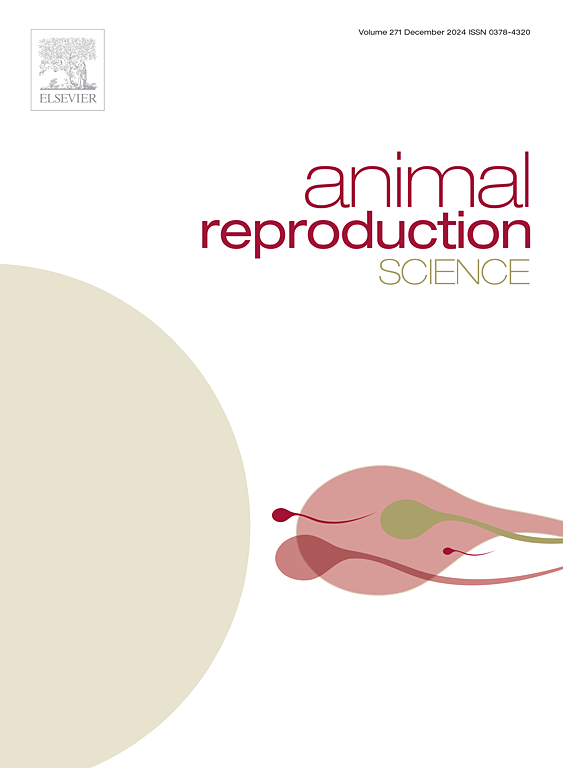家犬(Canis familiaris)尿液中雌二醇和孕二醇葡萄糖醛酸盐水平反映卵巢功能
IF 3.3
2区 农林科学
Q1 AGRICULTURE, DAIRY & ANIMAL SCIENCE
引用次数: 0
摘要
在许多哺乳动物中,生殖周期可以通过测量尿类固醇激素代谢物的浓度进行无创监测。然而,在家养狗中,关于雌激素和黄体酮尿液排泄的信息有限。estradiol-3-glucuronide (E2G)和pregnanediol-3-glucuronide (PdG)分别是雌二醇-17β和孕酮的尿液代谢物,通常被报道为哺乳动物尿液的成分。在这项研究中,我们收集了43只母狗在50个生殖周期中出现带血阴道分泌物后每天1至28份尿液样本。我们建立了一种ELISA方法来测定尿中E2G(9个周期)和PdG(50个周期)的浓度。采用线性混合模型估计E2G和PdG浓度的期望值和95 %置信区间。预计尿E2G在出现带血阴道分泌物后6天达到峰值,并在一周内降至最高浓度的三分之一。预期尿中PdG浓度在阴道带血性分泌物开始时较低,此后缓慢升高,在三周内达到最高浓度。E2G和PdG模型与现有文献的相似性表明,尿类固醇代谢物可能是检测雌性犬卵巢功能的有用生物标志物。E2G和PdG测量在发情监测中的适用性有待进一步深入研究。总之,测量尿液中类固醇激素的代谢物是一种很有前途的非侵入性方法,用于研究母狗的生殖生理。本文章由计算机程序翻译,如有差异,请以英文原文为准。
Urinary levels of oestradiol and pregnanediol glucuronides reflect the ovarian function in the domestic dog (Canis familiaris)
In many mammals, the reproductive cycle can be non-invasively monitored by measuring the concentrations of urinary steroid hormone metabolites. In domestic dogs, however, there is limited information available on the urinary excretion of oestrogens and progesterone. Oestradiol-3-glucuronide (E2G) and pregnanediol-3-glucuronide (PdG), the urinary metabolites of oestradiol-17β and progesterone, respectively, are commonly reported components of mammalian urine. In this study, we collected one to 28 daily urine samples of 43 female dogs after the onset of sanguineous vaginal discharge during 50 reproductive cycles. We developed an ELISA method for the measurement of urinary concentrations of E2G (nine cycles) and PdG (50 cycles). A linear mixed model was used to estimate the expected values and 95 % confidence intervals for the E2G and PdG concentrations. The expected urinary E2G was estimated to peak 6 days after the onset of sanguineous vaginal discharge and to decrease to one-third of the maximum concentration within a week. The estimates of the expected urinary PdG concentrations were low at the onset of sanguineous vaginal discharge and increased slowly thereafter, reaching maximum concentrations within three weeks. The similarity of the E2G and PdG models with existing literature suggested that urinary steroid metabolites could be a useful biomarker for detecting ovarian function in female dogs. Further detailed investigation is needed to enhance the suitability of E2G and PdG measurements in monitoring of oestrus. In summary, measurement of the urinary metabolites of steroid hormones is a promising non-invasive method for studying reproductive physiology in female dogs.
求助全文
通过发布文献求助,成功后即可免费获取论文全文。
去求助
来源期刊

Animal Reproduction Science
农林科学-奶制品与动物科学
CiteScore
4.50
自引率
9.10%
发文量
136
审稿时长
54 days
期刊介绍:
Animal Reproduction Science publishes results from studies relating to reproduction and fertility in animals. This includes both fundamental research and applied studies, including management practices that increase our understanding of the biology and manipulation of reproduction. Manuscripts should go into depth in the mechanisms involved in the research reported, rather than a give a mere description of findings. The focus is on animals that are useful to humans including food- and fibre-producing; companion/recreational; captive; and endangered species including zoo animals, but excluding laboratory animals unless the results of the study provide new information that impacts the basic understanding of the biology or manipulation of reproduction.
The journal''s scope includes the study of reproductive physiology and endocrinology, reproductive cycles, natural and artificial control of reproduction, preservation and use of gametes and embryos, pregnancy and parturition, infertility and sterility, diagnostic and therapeutic techniques.
The Editorial Board of Animal Reproduction Science has decided not to publish papers in which there is an exclusive examination of the in vitro development of oocytes and embryos; however, there will be consideration of papers that include in vitro studies where the source of the oocytes and/or development of the embryos beyond the blastocyst stage is part of the experimental design.
 求助内容:
求助内容: 应助结果提醒方式:
应助结果提醒方式:


